一、负载均衡基础
-
什么是负载均衡?
-
将业务流量分发到多台服务器,提高并发处理能力和高可用性。
-
典型应用:Web服务、数据库、缓存集群。
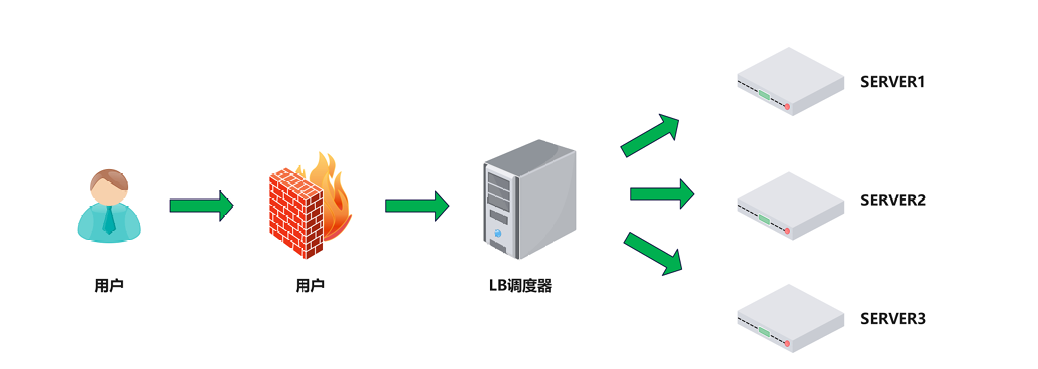
-
-
为什么需要负载均衡?
-
水平扩展服务器
-
解决单点性能瓶颈
-
节约公网IP成本
-
隐藏后端服务器IP
-
-
负载均衡类型对比
| 类型 | 工作层级 | 特点 | 适用场景 |
|---|---|---|---|
| 四层(L4) | 传输层 | 基于IP+端口转发,性能高 | TCP/UDP应用(如MySQL) |
| 七层(L7) | 应用层 | 解析HTTP头部,功能丰富 | Web服务、API网关 |
四层负载均衡

通过ip+port决定负载均衡的去向
对流量请求进行NAT处理,转发至后台服务器
记录tcp、udp流量分别是由哪台服务器处理,后续该请求连接的流量都通过该服务器处理
支持四层的软件:lvs 重量级四层负载均衡器(LVS只做流量传输)
客户端和RS之间也是有网络连接的
七层负载均衡
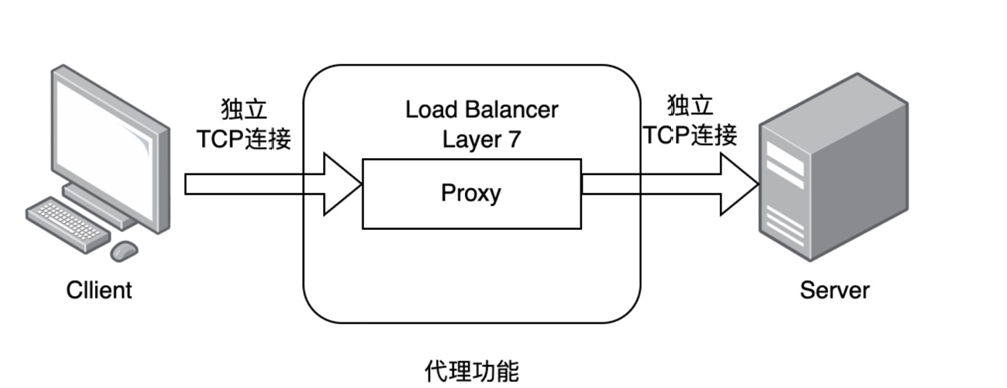
通过虚拟ur|或主机ip进行流量识别,根据应用层信息进行解析,决定是否需要进行负载均衡。
代理后台服务器与客户端建立连接,如nginx可代理前后端,与前端客户端tcp连接,与后端服务器建立tcp连接
支持7层代理的软件:
Nginx:基于http协议(nginx七层是通过proxy_pass).
Haproxy:七层代理,会话保持、标记、路径转移等。
Nginx:轻量级四层负载均衡器,可缓存(nginx四层是通过upstream模块)
Haproxy:模拟四层转发
四层和七层的区别
所谓的四到七层负载均衡,就是在对后台的服务器进行负载均衡时,依据四层的信息或七层的信息来决 定怎么样转发流量
四层的负载均衡,就是通过发布三层的IP地址(VIP),然后加四层的端口号,来决定哪些流量需要做负 载均衡,对需要处理的流量进行NAT处理,转发至后台服务器,并记录下这个TCP或者UDP的流量是由哪 台服务器处理的,后续这个连接的所有流量都同样转发到同一台服务器处理
七层的负载均衡,就是在四层的基础上**(没有四层是绝对不可能有七层的)** ,再考虑应用层的特征,比 如同一个Web服务器的负载均衡,除了根据VIP加80端口辨别是否需要处理的流量,还可根据七层的 URL、浏览器类别、语言来决定是否要进行负载均衡。
1.分层位置:四层负载均衡在传输层及以下,七层负载均衡在应用层及以下
2.性能 :四层负载均衡架构无需解析报文消息内容,在网络吞吐量与处理能力上较高:七层可支持解析应用 层报文消息内容,识别URL、Cookie、HTTP header等信息。
3.原理 :四层负载均衡是基于ip+port;七层是基于虚拟的URL或主机IP等。
4.功能类比:四层负载均衡类似于路由器;七层类似于代理服务器。
5.安全性:四层负载均衡无法识别DDoS攻击;七层可防御SYN Cookie/Flood攻击
二、HAProxy 核心配置
-
安装与基础配置
软件包下载地址: https://github.com/haproxy/wiki/wiki/Packages 安装软件包:bashdnf install haproxy -y查看版本:
root@haproxy \~\]# haproxy -v HAProxy version 2.4.22-f8e3218 2023/02/14 - https://haproxy.org/ Status: long-term supported branch - will stop receiving fixes around Q2 2026. Known bugs: http://www.haproxy.org/bugs/bugs-2.4.22.html Running on: Linux 5.14.0-427.13.1.el9_4.x86_64 #1 SMP PREEMPT_DYNAMIC Wed Apr 10 10:29:16 EDT 2024 x86_64
haproxy.cfg包括:
global:全局配置段
- 进程及安全配置相关的参数
- 性能调整相关参数
- Debug参数
proxies:代理配置段defaults:为frontend, backend, listen提供默认配置
frontend:前端,相当于nginx中的server { }
backend:后端,相当于nginx中的upstream { }
listen:同时拥有前端和后端配置,配置简单,生产推荐使用
代理中的参数会把默认中的参数覆盖,默认中的参数会把全局中的参数覆盖
global 配置参数说明
global log 127.0.0.1 local2 #定义全局的syslog服务器;日志服务器需要开启UDP协议,最多可以定义两个 chroot /var/lib/haproxy #锁定运行目录 pidfile /var/run/haproxy.pid #指定pid文件 maxconn 100000 #指定最大连接数 user haproxy #指定haproxy的运行用户 group haproxy #指定haproxy的运行组 daemon #指定haproxy以守护进程方式运行 # turn on stats unix socket stats socket /var/lib/haproxy/stats #指定haproxy的套接字文件 nbproc 2 #指定haproxy的work进程数量,默认是1个 cpu-map 1 0 #指定第一个work绑定第一个cpu核心 cpu-map 2 1 #指定第二个work绑定第二个cpu核心 nbthread 2 #指定haproxy的线程数量,默认每个进程一个线程,此参数与nbproc互斥 maxsslconn 100000 #每个haproxy进程ssl最大连接数,用于haproxy配置了证书的场景下 maxconnrate 100 #指定每个客户端每秒建立连接的最大数量
3.关键配置示例
**# ======================
前端配置(客户端入口)
======================
frontend web
监听所有IP的80端口(HTTP)
bind *:80
工作模式为HTTP(七层代理)
mode http
定义ACL规则:匹配静态资源请求(.jpg/.css/.js结尾的路径)
acl is_static path_end -i .jpg .css .js
如果匹配静态资源规则,则转发到static_servers后端
use_backend static_servers if is_static
其他请求默认转发到dynamic_servers后端
default_backend dynamic_servers**
**# ======================
静态资源后端配置
======================
backend static_servers
负载均衡算法:轮询(依次分发请求)
balance roundrobin
定义静态服务器节点
s1: 服务器名称
192.168.1.101:80: 服务器地址和端口
check: 启用健康检查(默认TCP端口检测)
server s1 192.168.1.101:80 check**
**# ======================
动态内容后端配置
======================
backend dynamic_servers
负载均衡算法:最小连接数(优先选择当前连接最少的服务器)
balance leastconn
定义动态服务器节点
d1: 服务器名称
192.168.1.102:8080: 服务器地址和端口(支持非标准端口)
check: 启用健康检查
server d1 192.168.1.102:8080 check**
多进程
global
log 127.0.0.1 local2
chroot /var/lib/haproxy
pidfile /var/run/haproxy.pid
maxconn 100000
user haproxy
group haproxy
daemon
turn on stats unix socket
stats socket /var/lib/haproxy/haproxy.sock1 mode 600 level admin process 1 #
启用多个sock文件
stats socket /var/lib/haproxy/haproxy.sock2 mode 600 level admin process 2
nbproc 2 #启用多进程
cpu-map 1 0 #进程和cpu核心绑定防止cpu抖动从而减少系统资源消耗
cpu-map 2 1 #2 表示第二个进程,1表示第二个cpu核心
多线程
log 127.0.0.1 local2
chroot /var/lib/haproxy
pidfile /var/run/haproxy.pid
maxconn 100000
user haproxy
group haproxy
daemon
turn on stats unix socket
stats socket /var/lib/haproxy/haproxy.sock1 mode 600 level admin process 1 # 启用多个sock文件
stats socket /var/lib/haproxy/haproxy.sock2 mode 600 level admin process 2
#nbproc 2
#cpu-map 1 0
#cpu-map 2 1
nbthread 2 #启用多线程
注意:多线程和多进程之间不能同时使用会互斥
如果开起了多线程,需要与cpu的核心绑定,不会出现交叉使用的现象
proxies参数说明
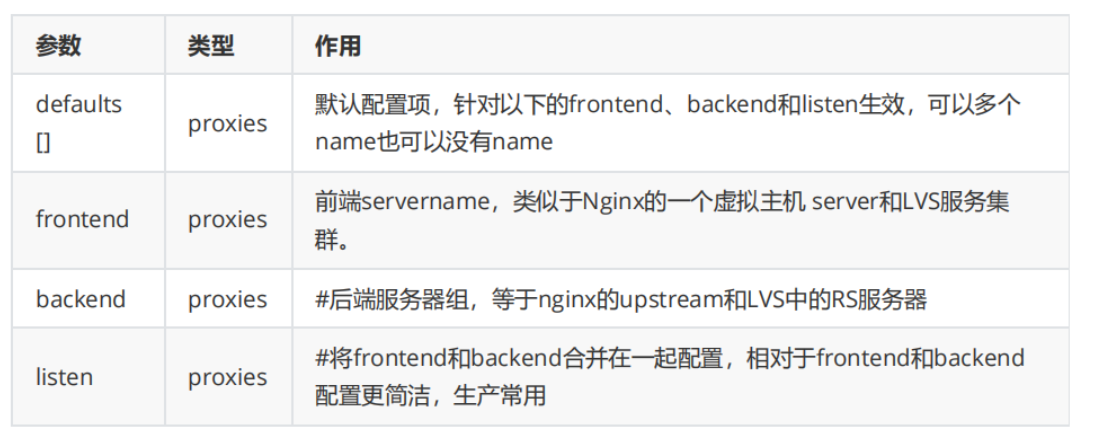
Proxies配置-defaults
defaults
mode http #HAProxy实例使用的连接协议
log global #指定日志地址和记录日志条目的 syslog/rsyslog日志设备
#此处的 global表示使用 global配置段中设定的log值。
option httplog #日志记录选项,httplog表示记录与 HTTP 会话相关的各种属性值
#包括 HTTP请求、会话状态、连接数、源地址以及连接时间等
option dontlognull #dontlognull表示不记录空会话连接日志
option http-server-close #等待客户端完整HTTP请求的时间,此处为等待10s。
option forwardfor except 127.0.0.0/8 #透传客户端真实IP至后端web服务器
#在apache配置文件中加入:<br>%{X-Forwarded-For}i
#后在webserver中看日志即可看到地址透传 信息
option redispatch #当server Id对应的服务器挂掉后,强制定 向到其他健康的服务器,重新派发
option http-keep-alive #开启与客户端的会话保持
retries 3 #连接后端服务器失败次数
timeout http-request 10s #等待客户端请求完全被接收和处理的最长时间
timeout queue 1m #设置删除连接和客户端收到503或服务不可用等提示信息前的等待时间
timeout connect 120s #设置等待服务器连接成功的时间
timeout client 600s #设置允许客户端处于非活动状态,即既不发 送数据也不接收数据的时间
timeout server 600s #设置服务器超时时间,即允许服务器处于既 不接收也不发送数据的非活动时间
timeout http-keep-alive 60s #session 会话保持超时时间,此时间段内会转发到相同的后端服务器
timeout check 10s #指定后端服务器健康检查的超时时间
maxconn 3000
default-server inter 1000 weight 3
server配置
#针对一个server配置
check #对指定real进行健康状态检查,如果不加此设置,默认不开启检查,只有check后面没 有其它配置也可以启用检查功能
#默认对相应的后端服务器IP和端口,利用TCP连接进行周期性健康性检查,注意必须指定端口才能实现健康性检查
addr <IP> #可指定的健康状态监测IP,可以是专门的数据网段,减少业务网络的流量
port <num> #指定的健康状态监测端口
inter <num> #健康状态检查间隔时间,默认2000 ms
fall <num> #后端服务器从线上转为线下的检查的连续失效次数,默认为3
rise <num> #后端服务器从下线恢复上线的检查的连续有效次数,默认为2
weight <weight> #默认为1,最大值为256,0(状态为蓝色)表示不参与负载均衡,但仍接受持久连接
backup #将后端服务器标记为备份状态,只在所有非备份主机down机时提供服务,类似Sorry Server
disabled #将后端服务器标记为不可用状态,即维护状态,除了持久模式
#将不再接受连接,状态为深黄色,优雅下线,不再接受新用户的请求
redirect prefix http://www.baidu.com/ #将请求临时(302)重定向至其它URL,只适用于http模
式
maxconn <maxconn> #当前后端server的最大并发连接数
**三、**haproxy的安装和服务信息
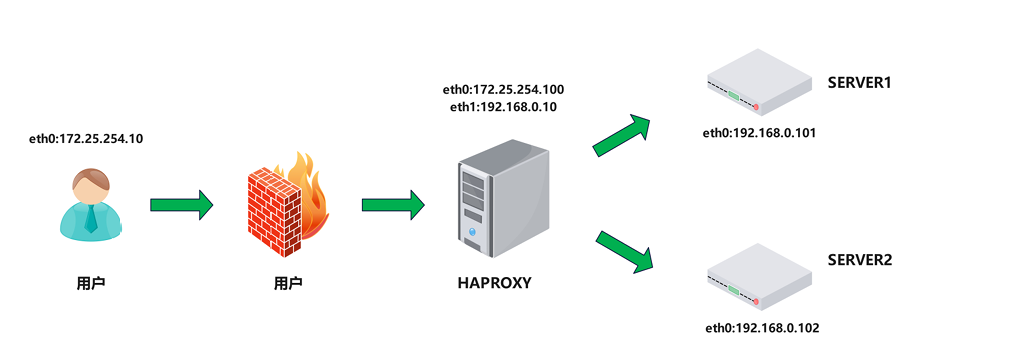
3.1.实验环境
3.2.软件安装
软件包下载地址
安装软件包:
haproxy ~]# dnf install haproxy -y
查看版本
root@haproxy \~\]# haproxy -v HAProxy version 2.4.22-f8e3218 2023/02/14 - https://haproxy.org/ Status: long-term supported branch - will stop receiving fixes around Q2 2026. Known bugs: http://www.haproxy.org/bugs/bugs-2.4.22.html Running on: Linux 5.14.0-427.13.1.el9_4.x86_64 #1 SMP PREEMPT_DYNAMIC Wed Apr 10 10:29:16 EDT 2024 x86_64
haproxy软件基本信息
软件安装包: haproxy-2.4.22-3.el9_3.x86_64.rpm
启动文件: /lib/systemd/system/haproxy.service
主配置目录: /etc/haproxy/ 主配置文件: /etc/haproxy/haproxy.cfg
子配置目录: /etc/haproxy/conf.d
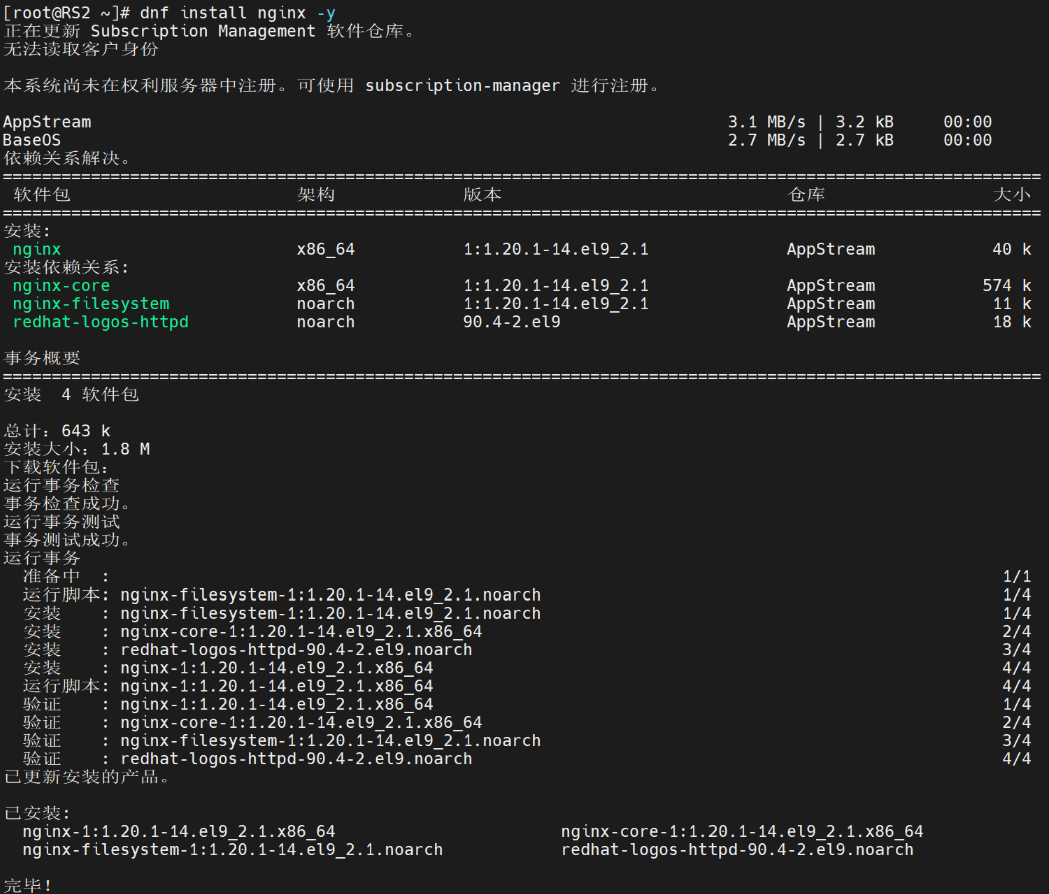
记得先把防火墙关了

启动nginx

在RS1和RS2中输入
bash
echo RS - 本机ip 》 /usr/share/nginx/html/index.html确保可以正常访问

可以写入

用前端来联通后端

它和客户端之间的是直连的,一定需要80端口

在配置文件里写可以访问到的RS的IP地址

将backend webserver修改
bash
backend webserver
server web1 192.168.0.101
server web2 192.168.0.102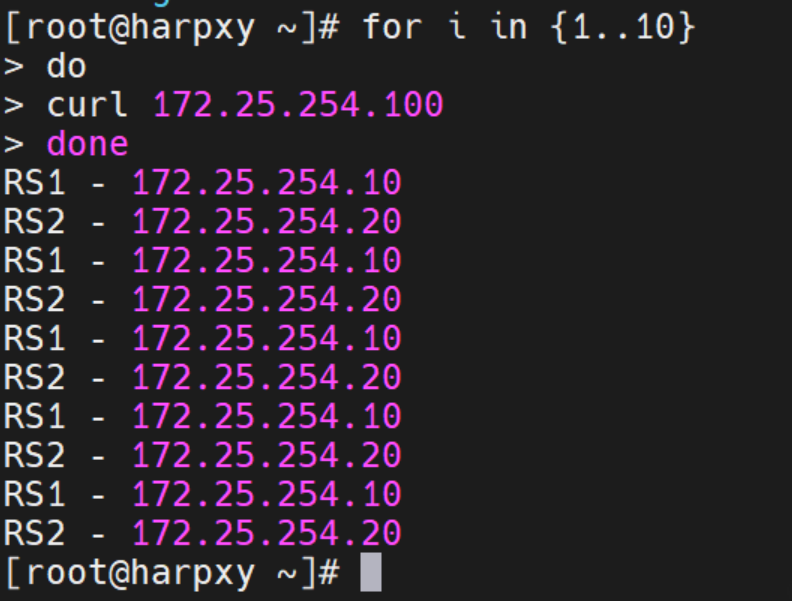
此时后端的是不可以知道是谁访问的,显示的都是100来访问

多进程和线程
global
log 127.0.0.1 local2
chroot /var/lib/haproxy
pidfile /var/run/haproxy.pid
maxconn 100000
user haproxy
group haproxy
daemon
turn on stats unix socket
stats socket /var/lib/haproxy/haproxy.sock1 mode 600 level admin process 1 #
启用多个sock文件
stats socket /var/lib/haproxy/haproxy.sock2 mode 600 level admin process 2
nbproc 2 #启用多进程
cpu-map 1 0 #进程和cpu核心绑定防止cpu抖动从而减少系统资源消耗
cpu-map 2 1 #2 表示第二个进程,1表示第二个cpu核心
nbproc 2后接了几个数字就会开几个work,把主进程分成了多个子进程,和核有关,不是越多越好
实验:
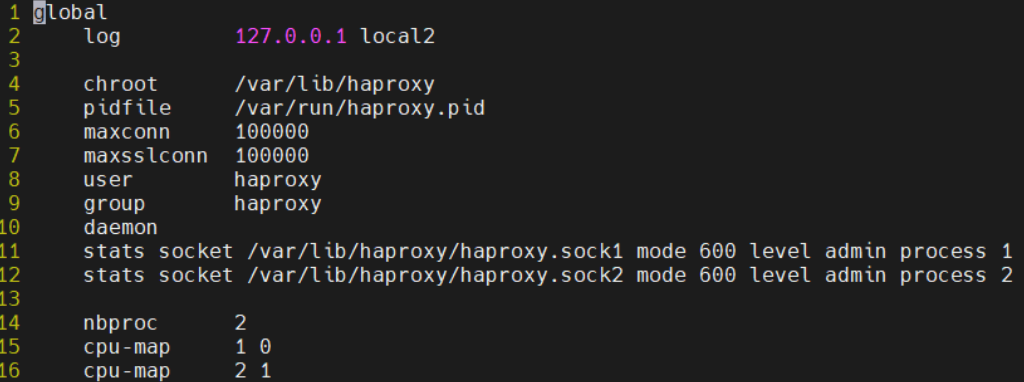

这里可以看出是一个父程序(haproxy)后接了两个子程序,子进程通常负责 流量转发、负载均衡
启动多线程
注意:多线程和多进程之间不能同时使用会互斥
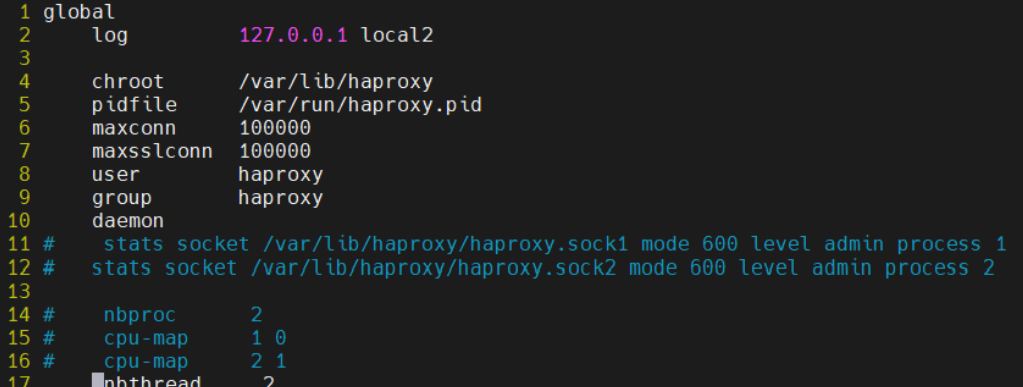

如果开起了多线程,需要与cpu的核心绑定,不会出现交叉使用的现象
关于权重weight的实验
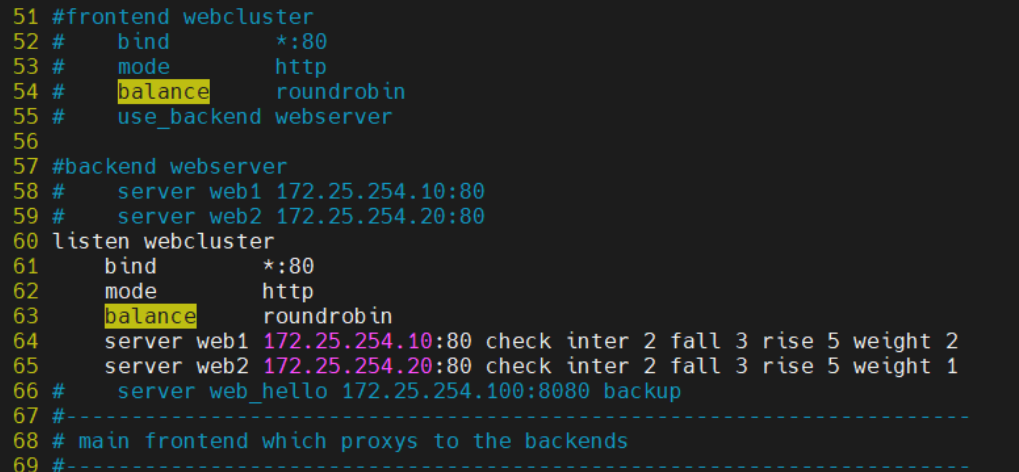

backend
注意:此时此刻要注意要关闭web1和web2的内容


bash
echo this is test page!> /var/www/html/index.html
redirect prefix http://www.baidu.com/ ---重定向网页

maxconn <maxconn>

socat工具
对服务器动态权重和其它状态可以利用 socat工具进行调整,Socat 是 Linux 下的一个多功能的网络工具。
Socat 的主要特点就是在两个数据流之间建立双向通道,且支持众多协议和链接方式。
如 IP、TCP、 UDP、IPv6、Socket文件等。
准备:
model 666 权限 level admin级别

haproxy多进程如何热处理
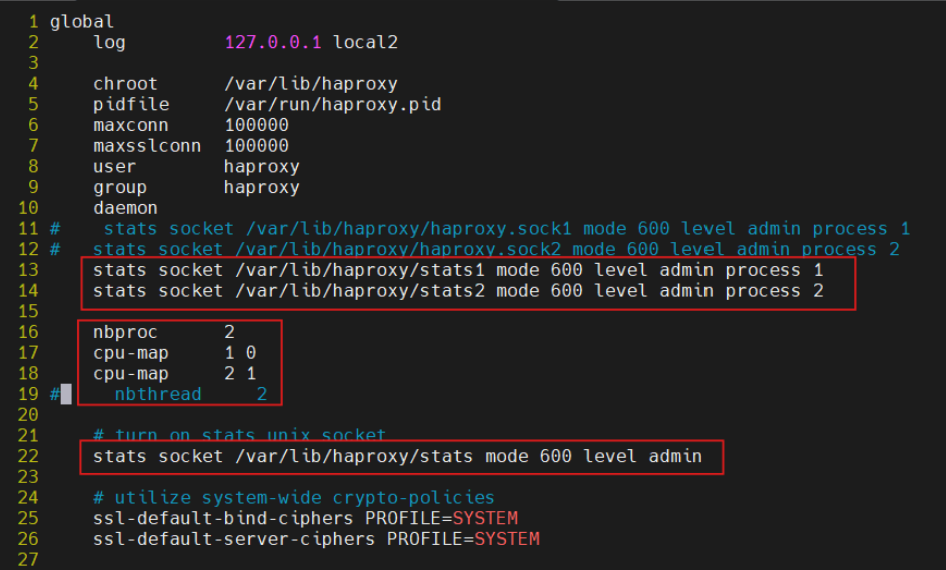
stdio标准的输入输出

四.haproxy的算法
HAProxy通过固定参数 balance 指明对后端服务器的调度算法
balance参数可以配置在listen或backend选项中。
HAProxy的调度算法分为静态和动态调度算法
有些算法可以根据参数在静态和动态算法中相互转换。
4.1 静态算法
静态算法:按照事先定义好的规则轮询公平调度,不关心后端服务器的当前负载、连接数和响应速度 等,且无法实时修改权重(只能为0和1,不支持其它值),只能靠重启HAProxy生效。
4.1.1
static-rr:
基于权重的轮询调度 不支持运行时利用socat进行权重的动态调整(只支持0和1,不支持其它值)
不支持端服务器慢启动 其后端主机数量没有限制,
相当于LVS中的 wrr
其实它的特点非常简单,首先它虽然是基于权重来分配,但实际上是按照定义好的规则顺序来分配的,并且当有新服务器时,完全不会有"新人保护期",上来就是满负载,并且对后端主机的数量没有限制。
Note
慢启动是指在服务器刚刚启动上不会把他所应该承担的访问压力全部给它,而是先给一部分,当没 问题后在给一部分 示例
haproxy ~]# vim /etc/haproxy/haproxy.cfg
...上面内容省略...
listen webserver_80
bind 172.25.254.100:80
mode http
balance static-rr
server webserver1 192.168.0.101:80 weight 2 check inter 3s fall 3 rise 5
server webserver2 192.168.0.102:80 weight 1 check inter 3s fall 3 rise 5
...上面内容省略...
4.1.2 first
根据服务器在列表中的位置,自上而下进行调度
其只会当第一台服务器的连接数达到上限,新请求才会分配给下一台服务
其会忽略服务器的权重设置
不支持用socat进行动态修改权重,可以设置0和1,可以设置其它值但无效
示例:
haproxy ~]# vim /etc/haproxy/haproxy.cfg
...上面内容省略...
listen webserver_80
bind 172.25.254.100:80
mode http
balance first
server webserver1 192.168.0.101:80 maxconn 3 check inter 3s fall 3 rise 5 server webserver2 192.168.0.102:80 check inter 3s fall 3 rise 5
...上面内容省略..
测试效果:
#在两台主机上分别执行此循环,可以观察是否102被调度到 while true;do curl 172.25.254.100 ; sleep 0.1;done
4.2 动态算法
动态算法
基于后端服务器状态进行调度适当调整,
新请求将优先调度至当前负载较低的服务器
权重可以在haproxy运行时动态调整无需重启
4.2.1 roundrobin
-
基于权重的轮询动态调度算法,
-
支持权重的运行时调整,不同于lvs中的rr轮训模式,
-
HAProxy中的roundrobin支持慢启动(新加的服务器会逐渐增加转发数),
-
其每个后端backend中最多支持4095个real server,
-
支持对real server权重动态调整,
-
roundrobin为默认调度算法,此算法使用广泛
示例:
haproxy ~]# vim /etc/haproxy/haproxy.cfg
...上面内容省略...
listen webserver_80
bind 172.25.254.100:80
mode http
balance roundrobin
server webserver1 192.168.0.101:80 weight 1 check inter 3s fall 3 rise 5
server webserver2 192.168.0.102:80 weight 1 check inter 3s fall 3 rise 5
...上面内容省略...
动态调整权重
root@haproxy \~\]# echo "set weight webserver_80/webserver1 2" \| socat stdio /var/lib/haproxy/haproxy.sock
4.2.2 leastconn
leastconn加权的最少连接的动态
支持权重的运行时调整和慢启动,即:根据当前连接最少的后端服务器而非权重进行优先调度(新客户 端连接)
比较适合长连接的场景使用,比如:MySQL等场景。
示例:
haproxy ~]# vim /etc/haproxy/haproxy.cfg
...上面内容省略...
listen webserver_80
bind 172.25.254.100:80
mode http
balance leastconn
server webserver1 192.168.0.101:80 weight 1 check inter 3s fall 3 rise 5
server webserver2 192.168.0.102:80 weight 1 check inter 3s fall 3 rise 5
...上面内容省略...
4.3 其他算法
其它算法即可作为静态算法,又可以通过选项成为动态算法
4.3.1 source
源地址hash,基于用户源地址hash并将请求转发到后端服务器,后续同一个源地址请求将被转发至同一 个后端web服务器。此方式当后端服务器数据量发生变化时,会导致很多用户的请求转发至新的后端服 务器,默认为静态方式,但是可以通过hash-type支持的选项更改这个算法一般是在不插入Cookie的TCP 模式下使用,也可给拒绝会话cookie的客户提供最好的会话粘性,适用于session会话保持但不支持 cookie和缓存的场景源地址有两种转发客户端请求到后端服务器的服务器选取计算方式,分别是取模法 和一致性hash
示例:
haproxy ~]# vim /etc/haproxy/haproxy.cfg
...上面内容省略...
listen webserver_80
bind 172.25.254.100:80
mode http
balance source
server webserver1 192.168.0.101:80 weight 1 check inter 3s fall 3 rise 5
server webserver2 192.168.0.102:80 weight 1 check inter 3s fall 3 rise 5
...上面内容省略..
测试:
root@node10 \~\]# for N in {1..6}; do curl 172.25.254.100; done RS1 server - 192.168.0.101 RS1 server - 192.168.0.101 RS1 server - 192.168.0.101 RS1 server - 192.168.0.101 RS1 server - 192.168.0.101 RS1 server - 192.168.0.101
如果访问客户端时一个家庭,那么所有的家庭的访问流量都会被定向到一台服务器,这时source算 法的缺陷
4.3.1.1 map-base 取模法
map-based:取模法,对source地址进行hash计算,再基于服务器总权重的取模,最终结果决定将此请 求转发至对应的后端服务器。
此方法是静态的,即不支持在线调整权重,不支持慢启动,可实现对后端服务器均衡调度
缺点是当服务器的总权重发生变化时,即有服务器上线或下线,都会因总权重发生变化而导致调度结果 整体改变
hash-type 指定的默值为此算法
所谓取模运算,就是计算两个数相除之后的余数,10%7=3, 7%4=3 map-based算法:基于权重取模,hash(source_ip)%所有后端服务器相加的总权重
比如当源hash值时1111,1112,1113,三台服务器a b c的权重均为1,
即abc的调度标签分别会被设定为 0 1 2(1111%3=1,1112%3=2,1113%3=0)
1111 ----- > nodeb
1112 ------> nodec
1113 ------> nodea
如果a下线后,权重数量发生变化
1111%2=1,1112%2=0,1113%2=1
1112和1113被调度到的主机都发生变化,这样会导致会话丢失
取模法配置示例:
haproxy ~]# vim /etc/haproxy/haproxy.cfg
...上面内容省略...
listen webserver_80
bind 172.25.254.100:80
mode http
balance source
server webserver1 192.168.0.101:80 weight 1 check inter 3s fall 3 rise 5
server webserver2 192.168.0.102:80 weight 1 check inter 3s fall 3 rise 5
...上面内容省略...
#不支持动态调整权重值
root@haproxy \~\]# echo "set weight webserver_80/webserver1 2" \| socat stdio /var/lib/haproxy/haproxy.sock Backend is using a static LB algorithm and only accepts weights '0%' and '100%'. #只能动态上线和下线 \[root@haproxy \~\]# echo "set weight webserver_80/webserver1 0" \| socat stdio /var/lib/haproxy/haproxy.sock \[root@haproxy \~\]# echo "get weight webserver_80/webserver1" \| socat stdio /var/lib/haproxy/haproxy.sock 0 (initial 1)
4.3.1.2 一致性hash
一致性哈希,当服务器的总权重发生变化时,对调度结果影响是局部的,不会引起大的变动hash(o) mod n
该hash算法是动态的,支持使用 socat等工具进行在线权重调整,支持慢启动
算法:
1、后端服务器哈希环点keyA=hash(后端服务器虚拟ip)%(2^32)
2、客户机哈希环点key1=hash(client_ip)%(2^32) 得到的值在[0---4294967295]之间,
3、将keyA和key1都放在hash环上,将用户请求调度到离key1最近的keyA对应的后端服务器

hash环偏斜问题
增加虚拟服务器IP数量,比如:一个后端服务器根据权重为1生成1000个虚拟IP,再hash。而后端服务器权 重为2则生成2000的虚拟IP,再bash,最终在hash环上生成3000个节点,从而解决hash环偏斜问题
hash对象
Hash对象到后端服务器的映射关系:
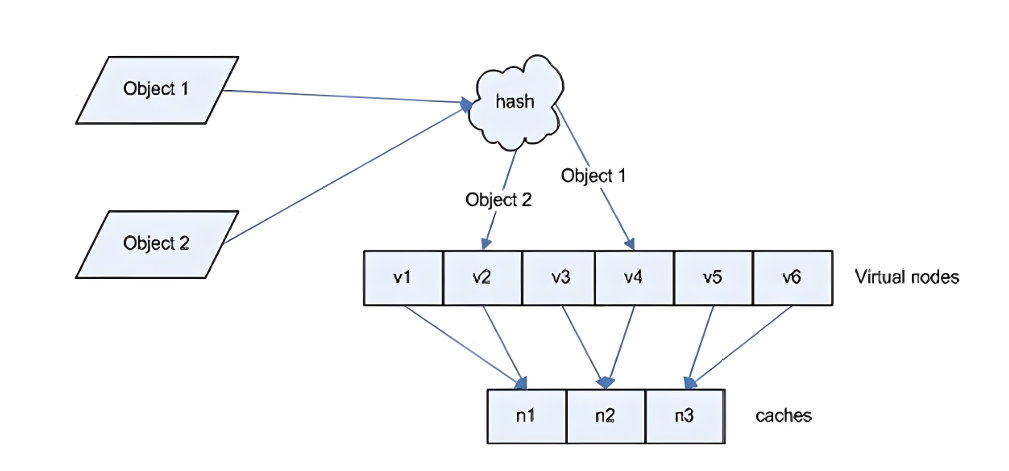
一致性hash示意图 后端服务器在线与离线的调度方式

一致性hash配置示例
haproxy ~]# vim /etc/haproxy/haproxy.cfg
...上面内容省略...
listen webserver_80
bind 172.25.254.100:80
mode http
balance source
hash-type consistent
server webserver1 192.168.0.101:80 weight 1 check inter 3s fall 3 rise 5
server webserver2 192.168.0.102:80 weight 1 check inter 3s fall 3 rise 5
...上面内容省略...
4.3.2 uri
基于对用户请求的URI的左半部分或整个uri做hash,再将hash结果对总权重进行取模后 根据最终结果将请求转发到后端指定服务器 适用于后端是缓存服务器场景 默认是静态算法,也可以通过hash-type指定map-based和consistent,来定义使用取模法还是一致性hash
注意;:此算法基于应用层,所以只支持 mode http ,不支持 mode tcp

4.3.2.1 uri 取模法配置示例
haproxy ~]# vim /etc/haproxy/haproxy.cfg
...上面内容省略...
listen webserver_80
bind 172.25.254.100:80
mode http
balance uri
server webserver1 192.168.0.101:80 weight 1 check inter 3s fall 3 rise 5
server webserver2 192.168.0.102:80 weight 1 check inter 3s fall 3 rise 5
...上面内容省略...
4.3.2.2 uri 一致性hash配置示例
haproxy ~]# vim /etc/haproxy/haproxy.cfg
...上面内容省略...
listen webserver_80
bind 172.25.254.100:80
mode http
balance uri
hash-type consistent
server webserver1 192.168.0.101:80 weight 1 check inter 3s fall 3 rise 5
server webserver2 192.168.0.102:80 weight 1 check inter 3s fall 3 rise 5
...上面内容省略...
4.3.2.3 访问测试
访问不同的uri,确认可以将用户同样的请求转发至相同的服务器
root@rs1 ~]# echo RS1 192.168.0.101 index1 > /var/www/html/index1.html
root@rs1 \~\]# echo RS1 192.168.0.101 index2 \> /var/www/html/index2.html \[root@rs1 \~\]# echo RS1 192.168.0.101 index3 \> /var/www/html/index3.html \[root@rs2 \~\]# echo RS1 192.168.0.102 index1 \> /var/www/html/index1.html \[root@rs2 \~\]# echo RS1 192.168.0.102 index2 \> /var/www/html/index2.html \[root@rs2 \~\]# echo RS1 192.168.0.102 index3 \> /var/www/html/index3.html \[root@node10 \~\]# curl 172.25.254.100/index.html RS2 server - 192.168.0.102 \[root@node10 \~\]# curl 172.25.254.100/index1.html RS1 192.168.0.101 index1 \[root@node10 \~\]# curl 172.25.254.100/index2.html RS1 192.168.0.102 index2 \[root@node10 \~\]# curl 172.25.254.100/index3.html RS1 192.168.0.101 index3
4.3.3 url_param
url_param对用户请求的url中的 params 部分中的一个参数key对应的value值作hash计算,并由服务器 总权重相除以后派发至某挑出的服务器,后端搜索同一个数据会被调度到同一个服务器,多用与电商
通常用于追踪用户,以确保来自同一个用户的请求始终发往同一个real server
如果无没key,将按roundrobin算法
#假设: url = http://www.timinglee.com/foo/bar/index.php?key=value
#则:
host = "www.timinglee.com"
url_param = "key=value"
4.3.3.1 url_param取模法配置示例
haproxy ~]# vim /etc/haproxy/haproxy.cfg
...上面内容省略...
listen webserver_80
bind 172.25.254.100:80
mode http
balance url_param name,userid #支持对多个url_param hash
server webserver1 192.168.0.101:80 weight 1 check inter 3s fall 3 rise 5
server webserver2 192.168.0.102:80 weight 1 check inter 3s fall 3 rise 5
...上面内容省略...
4.3.3.2 url_param一致性hash配置示例
haproxy ~]# vim /etc/haproxy/haproxy.cfg
...上面内容省略...
listen webserver_80
bind 172.25.254.100:80
mode http balance url_param name,userid #支持对多个url_param hash
hash-type consistent
server webserver1 192.168.0.101:80 weight 1 check inter 3s fall 3 rise 5
server webserver2 192.168.0.102:80 weight 1 check inter 3s fall 3 rise 5
...上面内容省略...
4.3.3.3 测试访问
bash
[root@node10 ~]# curl 172.25.254.100/index.html?name=timinglee
RS1 192.168.0.101 index3
[root@node10 ~]# curl 172.25.254.100/index.html?name=timinglee
RS1 192.168.0.101 index3
[root@node10 ~]# curl 172.25.254.100/index.html?userid=lee
RS1 192.168.0.102 index3
[root@node10 ~]# curl 172.25.254.100/index.html?userid=lee
RS1 192.168.0.102 index34.3.4 hdr
针对用户每个http头部(header)请求中的指定信息做hash, 此处由 name 指定的http首部将会被取出并做hash计算, 然后由服务器总权重取模以后派发至某挑出的服务器,如果无有效值,则会使用默认的轮询调度。
4.3.4.1 hdr取模法配置示例
bash
haproxy ~]# vim /etc/haproxy/haproxy.cfg
...上面内容省略...
listen webserver_80
bind 172.25.254.100:80
mode http
balance hdr(User-Agent)
server webserver1 192.168.0.101:80 weight 1 check inter 3s fall 3 rise 5
server webserver2 192.168.0.102:80 weight 1 check inter 3s fall 3 rise 5
...上面内容省略...4.3.4.2 一致性hash配置示例
bash
haproxy ~]# vim /etc/haproxy/haproxy.cfg
...上面内容省略...
listen webserver_80
bind 172.25.254.100:80
mode http
balance hdr(User-Agent)
hash-type consistent
server webserver1 192.168.0.101:80 weight 1 check inter 3s fall 3 rise 5
server webserver2 192.168.0.102:80 weight 1 check inter 3s fall 3 rise 5
...上面内容省略...4.3.4.3 测试访问
bash
[root@node10 ~]# curl -v 172.25.254.100
[root@node10 ~]# curl -vA "firefox" 172.25.254.100
[root@node10 ~]# curl -vA "sougou" 172.25.254.1004.3.6 算法总结
#静态
static-rr--------->tcp/http
first------------->tcp/http
#动态
roundrobin-------->tcp/http
leastconn--------->tcp/http
random------------>tcp/http
#以下静态和动态取决于hash_type是否consistent
source------------>tcp/http
Uri--------------->http
url_param--------->http
hdr--------------->http
4.3.7 各算法使用场景
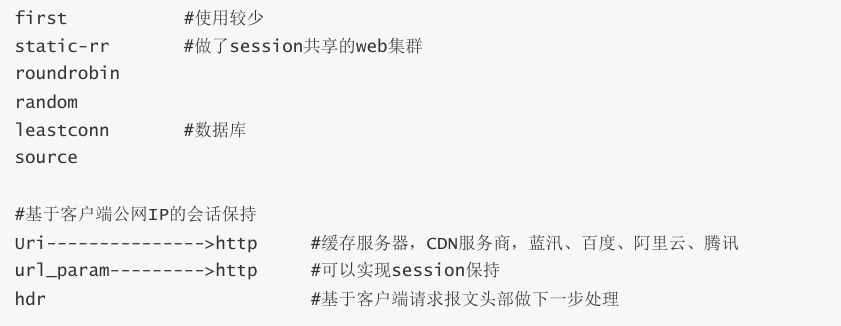
| 算法 | 类型 | 特点 | 适用场景 |
|---|---|---|---|
| roundrobin | 动态 | 轮询加权分发(默认) | 通用Web负载 |
| leastconn | 动态 | 优先选择连接数少的服务器 | 长连接服务(如DB) |
| source | 静态 | 按源IP哈希保持会话 | 无Cookie的应用 |
| uri | 动态 | 按URI路径哈希分发 | 缓存服务器 |
| url_param | 动态 | 按URL参数哈希 | 电商购物车 |
5.1 基于cookie的会话保持
cookie value:为当前server指定cookie值,实现基于cookie的会话黏性,相对于基于 source 地址hash 调度算法对客户端的粒度更精准,但同时也加大了haproxy负载,目前此模式使用较少, 已经被session 共享服务器代替
注意:不支持 tcp mode,使用 http mode
5.1.1 配置选项
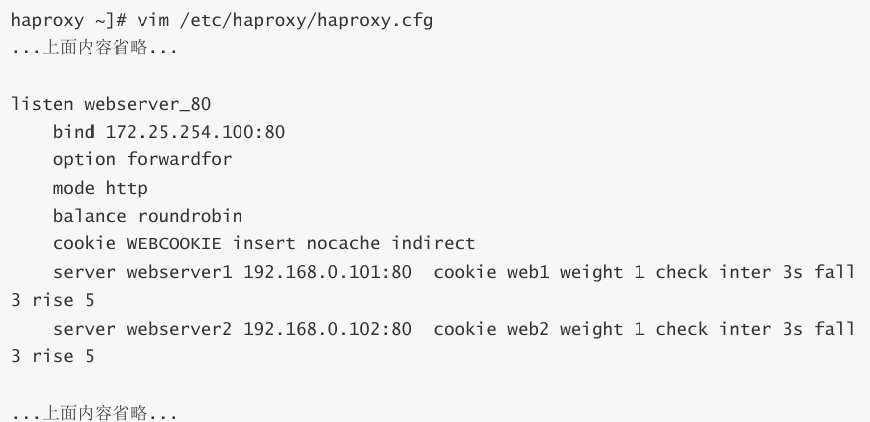
5.1.3 验证cookie信息
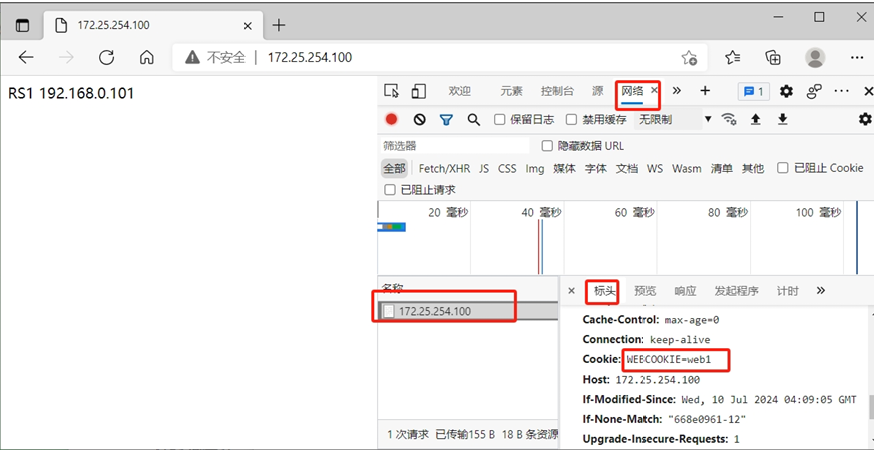
通过命令行验证:
bash
[root@node10 ~]# curl -i 172.25.254.100
HTTP/1.1 200 OK
date: Wed, 10 Jul 2024 16:36:17 GMT
server: Apache/2.4.6 (Red Hat Enterprise Linux) OpenSSL/1.0.2k-fips
last-modified: Thu, 04 Jul 2024 11:18:39 GMT
etag: "1b-61c6a1bd2408d"
accept-ranges: bytes
content-length: 27
content-type: text/html; charset=UTF-8
set-cookie: WEBCOOKIE=web2; path=/
cache-control: private
RS2 server - 192.168.0.102
[Administrator.WIN-20240602BIS] ➤ curl -i 172.25.254.100
HTTP/1.1 200 OK
server: nginx/1.20.1
date: Wed, 10 Jul 2024 08:36:43 GMT
content-type: text/html
content-length: 18
last-modified: Wed, 10 Jul 2024 04:09:05 GMT
etag: "668e0961-12"
accept-ranges: bytes
set-cookie: WEBCOOKIE=web1; path=/
cache-control: private
RS1 192.168.0.101
#curl访问时指定cookie
[root@node10 ~]# curl -b WEBCOOKIE=web1 172.25.254.100
RS1 server - 192.168.0.101
[root@node10 ~]# curl -b WEBCOOKIE=web2 172.25.254.100
RS2 server - 192.168.0.102
[root@node10 ~]# curl -vb WEBCOOKIE=web1 172.25.254.100
* About to connect() to 172.25.254.100 port 80 (#0)
*
Trying 172.25.254.100...
* Connected to 172.25.254.100 (172.25.254.100) port 80 (#0)
> GET / HTTP/1.1
> User-Agent: curl/7.29.0
> Host: 172.25.254.100
> Accept: */*
> Cookie: WEBCOOKIE=web1
>
< HTTP/1.1 200 OK
< server: nginx/1.20.1
< date: Wed, 10 Jul 2024 08:38:25 GMT
< content-type: text/html
< content-length: 18
< last-modified: Wed, 10 Jul 2024 04:09:05 GMT
< etag: "668e0961-12"
< accept-ranges: bytes
<
RS1 192.168.0.101
* Connection #0 to host 172.25.254.100 left intact5.2 HAProxy状态页
通过web界面,显示当前HAProxy的运行状态
5.2.1 状态页配置项
bash
stats enable
stats hide-version
stats refresh <delay>
stats uri <prefix>
#基于默认的参数启用stats page
#将状态页中haproxy版本隐藏
#设定自动刷新时间间隔,默认不自动刷新
#自定义stats page uri,默认值:/haproxy?stats
stats auth <user>:<passwd> #认证时的账号和密码,可定义多个用户,每行指定一个用户
#默认:no authentication
stats admin { if | unless } <cond> #启用stats page中的管理功能5.2.2 启用状态页
bash
haproxy ~]# vim /etc/haproxy/haproxy.cfg
...上面内容省略...
listen stats:
mode http
bind 0.0.0.0:8888
stats enable
log global
stats uri /status
stats auth lee:lee
...上面内容省略...
测试:
浏览器访问:172.25.254.100:8888/status5.2.3 登录状态页
bash
#pid为当前pid号,process为当前进程号,nbproc和nbthread为一共多少进程和每个进程多少个线程
pid = 27134 (process #1, nbproc = 1, nbthread = 1)
#启动了多长时间
uptime = 0d 0h00m04s
#系统资源限制:内存/最大打开文件数/
system limits: memmax = unlimited; ulimit-n = 200029
#最大socket连接数/单进程最大连接数/最大管道数maxpipes
maxsock = 200029; maxconn = 100000; maxpipes = 0
#当前连接数/当前管道数/当前连接速率
current conns = 2; current pipes = 0/0; conn rate = 2/sec; bit rate = 0.000 kbps
#运行的任务/当前空闲率
Running tasks: 1/14; idle = 100 %
active UP:
backup UP:
#在线服务器
#标记为backup的服务器
active UP, going down: #监测未通过正在进入down过程
backup UP, going down: #备份服务器正在进入down过程
active DOWN, going up: #down的服务器正在进入up过程
backup DOWN, going up: #备份服务器正在进入up过程
active or backup DOWN: #在线的服务器或者是backup的服务器已经转换成了down状态
not checked:
#标记为不监测的服务器
#active或者backup服务器人为下线的
active or backup DOWN for maintenance (MAINT)
#active或者backup被人为软下线(人为将weight改成0)
active or backup SOFT STOPPED for maintenance 5.2.4 backend server信息
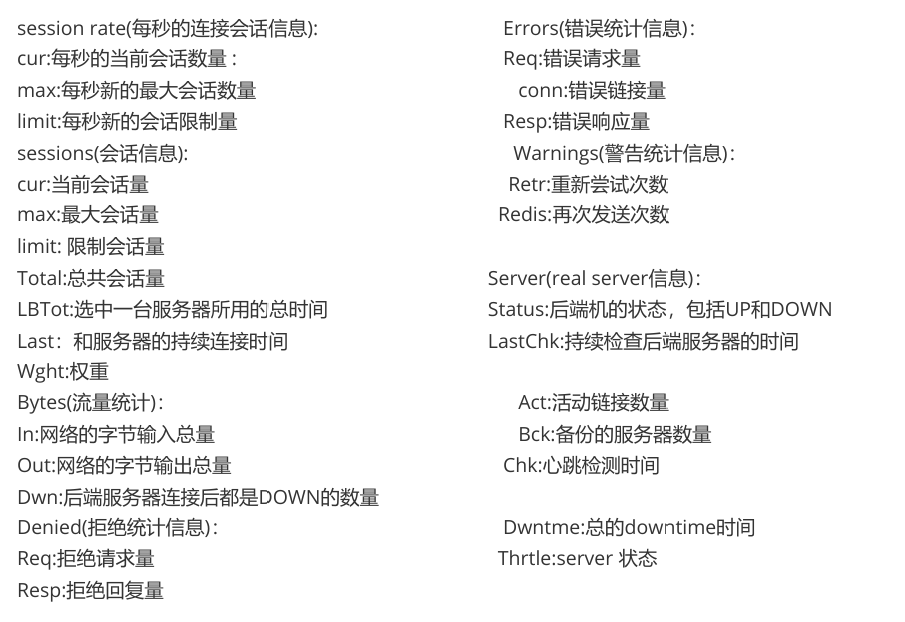
5.3 IP透传
web服务器中需要记录客户端的真实IP地址,用于做访问统计、安全防护、行为分析、区域排行等场景。
5.3.2 四层IP透传
bash
#未开启透传的四层代理
haproxy ~]# vim /etc/haproxy/haproxy.cfg
...上面内容省略...
listen webserver_80
bind 172.25.254.100:80
mode tcp
balance roundrobin
server webserver1 192.168.0.101:80 weight 1 check inter 3s fall 3 rise 5
...上面内容省略...
#正常的nginx配置
[root@rs1 ~]# vim /etc/nginx/nginx.conf
。。。内容省略。。。
http {
log_format main '$remote_addr - $remote_user [$time_local] "$request"'
'$status $body_bytes_sent "$http_referer" '
'"$http_user_agent" "$http_x_forwarded_for"';
。。。内容省略。。。
server {
listen 80;
listen [::]:80;
server_name _;
root /usr/share/nginx/html;
。。。内容省略。。。
}
}
#在访问haproxy后查看nginx日志
[root@rs1 ~]# tail -n 3 /var/log/nginx/access.log
192.168.0.10 - - [10/Jul/2024:15:21:00 +0800] "GET / HTTP/1.1"200 18 "-"
"curl/7.29.0" "-"192.168.0.10 - - [10/Jul/2024:15:26:11 +0800] "GET /
HTTP/1.1"200 18 "-" "curl/7.29.0" "-"
在此日志中是无法看到真实访问源地址的开启四层透传
bash
#nginx 配置:在访问日志中通过变量$proxy_protocol_addr 记录透传过来的客户端IP
[root@rs1 ~]# vim /etc/nginx/nginx.conf
。。。内容省略。。。
http {
log_format main '$remote_addr - $remote_user [$time_local] "$request"'
' "$proxy_protocol_addr"'
'$status $body_bytes_sent "$http_referer" '
'"$http_user_agent" "$http_x_forwarded_for"';
。。。内容省略。。。
server {
listen
访问
listen
80 proxy_protocol; #启用此项,将无法直接访问此网站,只能通过四层代理
[::]:80;
server_name _;
root
/usr/share/nginx/html;
。。。内容省略。。。
}
}
#修改haproxy
haproxy ~]# vim /etc/haproxy/haproxy.cfg
...上面内容省略...
...上面内容省略...
listen webserver_80
bind 172.25.254.100:80
mode tcp
balance roundrobin
server webserver1 192.168.0.101:80 send-proxy weight 1 check inter 3s fall 3
rise 5
#查看日志内容
[root@rs1 ~]# tail -n 3 /var/log/nginx/access.log
192.168.0.10 - - [10/Jul/2024:15:21:00 +0800] "GET / HTTP/1.1"200 18 "-"
"curl/7.29.0" "-"
192.168.0.10 - - [10/Jul/2024:15:26:11 +0800] "GET / HTTP/1.1"200 18 "-"
"curl/7.29.0" "-"
192.168.0.10 - - [10/Jul/2024:15:41:56 +0800] "GET / HTTP/1.1" "172.25.254.10"200
18 "-" "curl/7.29.0"5.3.3 七层IP透传
当haproxy工作在七层的时候,也可以透传客户端真实IP至后端服务器
5.3.3.1 HAProxy配置
在由haproxy发往后端主机的请求报文中添加"X-Forwarded-For"首部,其值为前端客户端的地址;用于 向后端主发送真实的客户端IP

示例:
bash
#修改haproxy
haproxy ~]# vim /etc/haproxy/haproxy.cfg
...上面内容省略...
listen webserver_80
option forwardfor
bind 172.25.254.100:80
mode http
balance roundrobin
server webserver1 192.168.0.101:80 send-proxy weight 1 check inter 3s fall 3
rise 5
server webserver1 192.168.0.102:80 weight 1 check inter 3s fall 3 rise 5
...上面内容省略...5.3.3.2 web服务器日志格式配置
配置web服务器,记录负载均衡透传的客户端IP地址
bash
#apache 配置:
LogFormat "%{X-Forwarded-For}i %a %l %u %t \"%r\" %>s %b \"%{Referer}i\" \"%
{User-Agent}i\"" combined
#nginx 日志格式:
$proxy_add_x_forwarded_for: 包括客户端IP和中间经过的所有代理的IP
$http_x_forwarded_For: 只有客户端IP
log_format main '"$proxy_add_x_forwarded_for" - $remote_user [$time_local]
"$request" '
'$status $body_bytes_sent "$http_referer" '
'"$http_user_agent" $http_x_forwarded_For';
#查看日志如下:
[root@rs1 ~]# tail -n 3 /var/log/nginx/access.log
"172.25.254.10, 192.168.0.10" 192.168.0.10 - - [10/Jul/2024:16:15:00 +0800] "GET
/ HTTP/1.1"200 18 "-" "curl/7.29.0" "172.25.254.10"
[root@rs2 ~]# tail -n 3 /etc/httpd/logs/access_log
172.25.254.10 192.168.0.10 - - [11/Jul/2024:00:15:00 +0800] "GET / HTTP/1.1" 200
27 "-" "curl/7.29.0"5.4 ACL
访问控制列表ACL,Access Control Lists)
是一种基于包过滤的访问控制技术
它可以根据设定的条件对经过服务器传输的数据包进行过滤(条件匹配)即对接收到的报文进行匹配和过 滤,基于请求报文头部中的源地址、源端口、目标地址、目标端口、请求方法、URL、文件后缀等信息内 容进行匹配并执行进一步操作,比如允许其通过或丢弃。
bash
#示例
frontend test_acl
bind *:80
mode http
#acl bad_browers hdr_beg(User-Agent) -i curl
#http-request deny if bad_browers
#acl test hdr_dom(host) -i www.timinglee.org
#acl test hdr_end(host) -i .org
#acl test base_sub -m sub org
#acl test path_sub -m sub /a
#acl test path_end -m sub /a
#acl test path_reg -i ^/t
acl test url_sub -m sub lee
acl test path_dir -m sub a
use_backend test_web if test
default_backend default_webserver
backend default_webserver
mode http
server web1 172.25.254.20:80 check inter 3 fall 3 rise 5
backend test_web
mode http
server web2 172.25.254.30:80 check inter 3 fall 3 rise 55.4.1 ACL配置选项

5.4.1.1 ACL-Name 名称

5.4.1.2 ACL-criterion 匹配规范
定义ACL匹配规范,即:判断条件
bash
hdr string,提取在一个HTTP请求报文的首部
hdr([<name> [,<occ>]]):完全匹配字符串,header的指定信息,<occ> 表示在多值中使用的值的出
现次数
hdr_beg([<name> [,<occ>]]):前缀匹配,header中指定匹配内容的begin
hdr_end([<name> [,<occ>]]):后缀匹配,header中指定匹配内容end
hdr_dom([<name> [,<occ>]]):域匹配,header中的dom(host)
hdr_dir([<name> [,<occ>]]):路径匹配,header的uri路径
hdr_len([<name> [,<occ>]]):长度匹配,header的长度匹配
hdr_reg([<name> [,<occ>]]):正则表达式匹配,自定义表达式(regex)模糊匹配
hdr_sub([<name> [,<occ>]]):子串匹配,header中的uri模糊匹配 模糊匹配c 报文中a/b/c也会匹
配
#示例:
hdr(<string>) 用于测试请求头部首部指定内容
hdr_dom(host) 请求的host名称,如 www.timinglee.org
hdr_beg(host) 请求的host开头,如 www. img. video. download. ftp.
hdr_end(host) 请求的host结尾,如 .com .net .cn
#示例:
acl bad_agent hdr_sub(User-Agent) -i curl wget
http-request deny if bad_agent
#有些功能是类似的,比如以下几个都是匹配用户请求报文中host的开头是不是www
acl short_form hdr_beg(host)
www.
acl alternate1 hdr_beg(host) -m beg www.
acl alternate2 hdr_dom(host) -m beg www.
acl alternate3 hdr(host) -m beg www.
: exact string match
base_beg : prefix match
base_dir : subdir match
base_dom : domain match
base_end : suffix match
base_len : length match
base_reg : regex match
base_sub : substring match
base : string
#返回第一个主机头和请求的路径部分的连接,该请求从主机名开始,并在问号之前结束,对虚拟主机有用
<scheme>://<user>:<password>@#<host>:<port>/<path>;<params>#?<query>#<frag>
base
path : string
#提取请求的URL路径,该路径从第一个斜杠开始,并在问号之前结束(无主机部分)
<scheme>://<user>:<password>@<host>:<port>#/<path>;<params>#?<query>#<frag>
path
: exact string match
path_beg : prefix match #请求的URL开头,如/static、/images、/img、/css
path_end : suffix match #请求的URL中资源的结尾,如 .gif .png .css .js .jpg .jpeg
path_dom : domain match
path_dir : subdir match
path_len : length match
path_reg : regex match
path_sub : substring match
#示例:
path_beg -i /haproxy-status/
path_end .jpg .jpeg .png .gif
path_reg ^/images.*\.jpeg$
path_sub image
path_dir jpegs
path_dom timinglee
url : string
#提取请求中的整个URL。
url :exact string match
url_beg : prefix match
url_dir : subdir match
url_dom : domain match
url_end : suffix match
url_len : length match
url_reg : regex match
url_sub : substring match
dst
#目标IP
dst_port #目标PORT
src
#源IP
src_port #源PORT
#示例:
acl invalid_src src 10.0.0.7 192.168.1.0/24
acl invalid_src src 172.16.0.0/24
acl invalid_port src_port 0:1023
status : integer #返回在响应报文中的状态码
#七层协议
acl valid_method method GET HEAD
http-request deny if ! valid_method5.4.1.3 ACL-flags 匹配模式
ACL匹配模式
-i 不区分大小写
-m 使用指定的正则表达式匹配方法
-n 不做DNS解析
-u 禁止acl重名,否则多个同名ACL匹配或关系
5.4.1.4 ACL-operator 具体操作符
ACL 操作符
整数比较:eq、ge、gt、le、lt
字符比较:
exact match (-m str) :字符串必须完全匹配模式
substring match (-m sub) :在提取的字符串中查找模式,如果其中任何一个被发现,ACL将匹配
prefix match (-m beg) :在提取的字符串首部中查找模式,如果其中任何一个被发现,ACL将匹配
suffix match (-m end) :将模式与提取字符串的尾部进行比较,如果其中任何一个匹配,则ACL进行 匹配
subdir match (-m dir) :查看提取出来的用斜线分隔("/")的字符串,如其中任一个匹配,则ACL 进行匹配
domain match (-m dom) :查找提取的用点(".")分隔字符串,如果其中任何一个匹配,则ACL进行 匹配
5.4.1.5 ACL-value 操作对象
value的类型
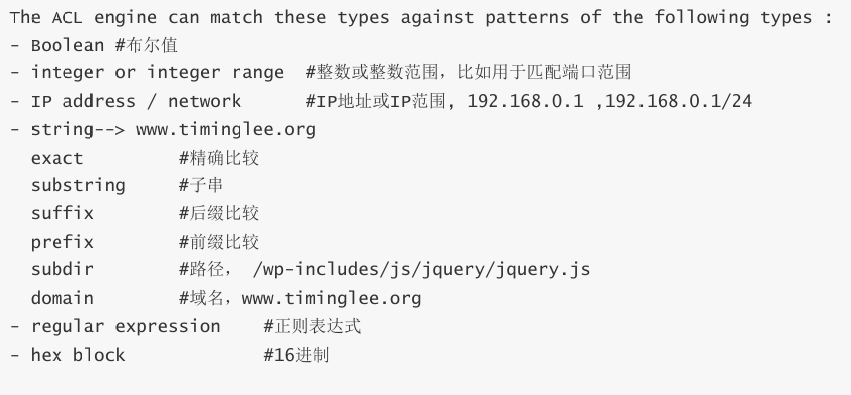
5.4.2 多个ACL的组合调用方式
多个ACL的逻辑处理
与:隐式(默认)使用
或:使用"or" 或 "||"表示
否定:使用 "!" 表示
多个ACL调用方式:
#示例:
if valid_src valid_port #与关系,ACL中A和B都要满足为true,默认为与
if invalid_src || invalid_port #或,ACL中A或者B满足一个为true
if ! invalid_src #非,取反,不满足ACL才为true
5.4.3 ACL示例-域名匹配
bash
haproxy ~]# vim /etc/haproxy/haproxy.cfg
...上面内容省略...
frontend testacl
bind :80
mode http
###########
ACL settings
#######################
acl web_host hdr_dom(host) www.timinglee.org
###########
host
###########################
use_backend timinglee_host if web_host
###########
default server
default_backend default_webserver
###################
backend timinglee_host
mode http
server web1 192.168.0.101:80 check weight 1 inter 3s fall 3 rise 5
server web2 192.168.0.102:80 check weight 1 inter 3s fall 3 rise 5
backend default_webserver
mode http
server web1 172.25.254.10:80 check weight 1 inter 3s fall 3 rise 5
...上面内容省略...测试结果:
bash
#在浏览器所在主机中做地址解析
[root@node10 html]# vim /etc/hosts
172.25.254.100
www.timinglee.org
#测试结果
[root@node10 html]# curl www.timinglee.org
RS1 192.168.0.101
[root@node10 html]# curl www.timinglee.org
RS2 server - 192.168.0.102
[root@node10 html]# curl 172.25.254.100
default web server node105.4.4 ACL示例-基于源IP或子网调度访问
将指定的源地址调度至指定的web服务器组。
bash
haproxy ~]# vim /etc/haproxy/haproxy.cfg
...上面内容省略...
frontend testacl
bind :80
mode http
###########
ACL settings
#######################
acl ip_test src 172.25.254.1 192.168.0.0/24
###########
host
###########################
use_backend ip_test-host if ip_test
###########
default server
default_backend default_webserver
###################
backend ip_test-host
mode http
server web1 192.168.0.101:80 check weight 1 inter 3s fall 3 rise 5
backend default_webserver
mode http
server web1 172.25.254.10:80 check weight 1 inter 3s fall 3 rise 5测试结果
bash
[172.25.254.10 root@node10 html]# curl 172.25.254.100
default web server node10
[172.25.254.1 Administrator.WIN-20240602BIS] ➤ curl 172.25.254.100
RS1 192.168.0.101
[192.168.0.102 root@rs1 ~]# curl 192.168.0.101
RS1 192.168.0.1015.4.5 ACL示例-基于源地址的访问控制
拒绝指定IP或者IP范围访问
bash
haproxy ~]# vim /etc/haproxy/haproxy.cfg
...上面内容省略...
frontend testacl
bind :80
mode http
###########
ACL settings
#######################
acl web_host hdr_dom(host) www.timinglee.org
acl ip_test src 172.25.254.1 192.168.0.0/24
###########
host
###########################
http-request deny if web_host
###########
default server
###################
default_backend default_webserver
backend ip_test-host
mode http
server web1 192.168.0.101:80 check weight 1 inter 3s fall 3 rise 5
backend default_webserver
mode http
server web1 172.25.254.10:80 check weight 1 inter 3s fall 3 rise 5测试
bash
[root@node10 ~]# curl www.timinglee.org
<html><body><h1>403 Forbidden</h1>
Request forbidden by administrative rules.
</body></html>
[root@node10 ~]# curl 172.25.254.100
default web server node105.4.6 ACL示例-匹配浏览器类型
匹配客户端浏览器,将不同类型的浏览器调动至不同的服务器组、
范例: 拒绝curl和wget的访问
示例:
bash
haproxy ~]# vim /etc/haproxy/haproxy.cfg
...上面内容省略...
frontend testacl
bind :80
mode http
###########
ACL settings
#######################
acl user_agent_block hdr_sub(User-Agent) -i curl wget
acl user_agent_redirect hdr_sub(User-Agent) -i Mozilla/5.0
###########
###########
host
###########################
http-request deny if user_agent_block
redirect prefix https://www.baidu.com if user_agent_redirect
default server
default_backend default_webserver
###################
backend ip_test-host
mode http
server web1 192.168.0.101:80 check weight 1 inter 3s fall 3 rise 5
backend default_webserver
mode http
server web1 172.25.254.10:80 check weight 1 inter 3s fall 3 rise 5测试:
bash
1。
[root@node10 ~]# curl 172.25.254.100
<html><body><h1>403 Forbidden</h1>
Request forbidden by administrative rules.
</body></html>
2.
[root@node10 ~]# wget http://172.25.254.100/index.html--2024-07-11 23:04:36-- http://172.25.254.100/index.html
Connecting to 172.25.254.100:80... connected.
HTTP request sent, awaiting response... 403 Forbidden
2024-07-11 23:04:36 ERROR 403: Forbidden.
3.浏览器中测试5.4.7 ACL示例-基于文件后缀名实现动静分离
bash
haproxy ~]# vim /etc/haproxy/haproxy.cfg
...上面内容省略...
frontend testacl
bind :80
mode http
###########
ACL settings
#######################
acl url_static path_end -i .jpg .png .css .js .html
acl url_php
path_end -i .php
###########
host
###########################
use_backend static_host if url_static
use_backend php_host if url_php
###########
default server
default_backend default_webserver
###################
backend static_host
mode http
server web2 192.168.0.101:80 check weight 1 inter 3s fall 3 rise 5
backend php_host
mode http
server web1 192.168.0.102:80 check weight 1 inter 3s fall 3 rise 5
backend default_webserver
mode http
server web1 172.25.254.10:80 check weight 1 inter 3s fall 3 rise 5测试:
bash
[root@rs1 ~]# echo css 192.168.0.101 > /usr/share/nginx/html/index.css
[root@rs2 ~]# echo php 192.168.0.102 > /var/www/html/index.php
[root@node10 ~]# curl 172.25.254.100/index.php
php 192.168.0.102
[root@node10 ~]# curl 172.25.254.100/index.css
css 192.168.0.1015.4.8 ACL-匹配访问路径实现动静分离
bash
haproxy ~]# vim /etc/haproxy/haproxy.cfg
...上面内容省略...
frontend testacl
bind :80
mode http
###########
ACL settings
#######################
acl url_static path_end -i .jpg .png .css .js .html
acl url_static path_end -m sub /static /images /javascript
acl acl_app
path_beg -m sub /api
###########
###########
host
###########################
use_backend static_host if url_static
use_backend api_host if acl_app
default server
default_backend default_webserver
###################
backend static_host
mode http
server web2 192.168.0.101:80 check weight 1 inter 3s fall 3 rise 5
backend api_host
mode http
server web1 192.168.0.102:80 check weight 1 inter 3s fall 3 rise 5
backend default_webserver
mode http
server web1 172.25.254.10:80 check weight 1 inter 3s fall 3 rise 5
#创建相关文件
[root@rs1 ~]# mkdir /usr/share/nginx/html/static
[root@rs1 ~]# echo static 192.168.0.101 > /usr/share/nginx/html/static/index.html
[root@rs2 ~]# mkdir /var/www/html/api/
[root@rs2 ~]# echo api 192.168.0.102 > /var/www/html/api/index.html
#测试访问
[root@node10 ~]# curl 172.25.254.100/api/
api 192.168.0.102
[root@node10 ~]# curl 172.25.254.100/static/
static 192.168.0.1015.5 自定义HAProxy 错误界面
对指定的报错进行重定向,进行优雅的显示错误页面
使用errorfile和errorloc指令的两种方法,可以实现自定义各种错误页面
bash
#haproxy默认使用的错误错误页面
[root@haproxy ~]# rpm -ql haproxy24z-2.4.27-1.el7.zenetys.x86_64 | grep -E http$
/usr/share/haproxy/400.http
/usr/share/haproxy/403.http
/usr/share/haproxy/408.http
/usr/share/haproxy/500.http
/usr/share/haproxy/502.http
/usr/share/haproxy/503.http
/usr/share/haproxy/504.http5.5.1 基于自定义的错误页面文件
bash
#自定义错误页
errorfile <code> <file>
<code> #HTTP status code.支持200, 400, 403, 405, 408, 425, 429, 500, 502,503,504
<file> #包含完整HTTP响应头的错误页文件的绝对路径。 建议后缀".http",以和一般的html文件相区分
#示例:
errorfile 503 /haproxy/errorpages/503page.http示例:
bash
haproxy ~]# vim /etc/haproxy/haproxy.cfg
...上面内容省略...
defaults
mode http
...内容省略...
timeout client 1m
timeout server 1m
timeout http-keep-alive 10s
timeout check 10s
maxconn 1000000
errorfile 503 /haproxy/errorpages/503page.http
[root@haproxy ~]# mkdir /haproxy/errorpages/ -p
[root@haproxy ~]# cp /usr/share/haproxy/503.http /haproxy/errorpages/503page.http
[root@haproxy ~]# vim /haproxy/errorpages/503page.http
HTTP/1.0 503 Service Unavailable
Cache-Control: no-cache
Connection: close
Content-Type: text/html;charset=UTF-8^M
<html><body><h1>什么动物生气最安静</h1>
大猩猩!!
</body></html>测试:
关闭后端的RS主机 然后用浏览器去访问172.25.254.100
5.5.2 基于http重定向错误页面
bash
#错误页面重定向
errorloc <code> <url>
#相当于errorloc302 <code> <url>,利用302重定向至指URL
#示例:
errorloc 503 https://www.baidu.com范例:
bash
haproxy ~]# vim /etc/haproxy/haproxy.cfg
...上面内容省略...
defaults
mode http
...内容省略...
timeout client 1m
timeout server 1m
timeout http-keep-alive 10s
timeout check 10s
maxconn
1000000
errorloc 503 https://www.baidu.com
#浏览器访问172.25.254.100 自动跳转到百度5.6 HAProxy 四层负载
针对除HTTP以外的TCP协议应用服务访问的应用场景
MySQL
Redis
Memcache
RabbitMQ
四层负载示例
注意:如果使用frontend和backend,一定在 frontend 和 backend 段中都指定mode tcp
bash
listen mysql-port
bind 10.0.0.7:6379
mode tcp
balance leastconn
server server1 10.0.0.17:3306 check
server server2 10.0.0.27:3306 check backup范例:对 MySQL 服务实现四层负载
bash
haproxy ~]# vim /etc/haproxy/haproxy.cfg
...上面内容省略...
listen mysql_port
bind :3306
mode tcp
balance leastconn
server mysql1 192.168.0.101:3306 check
server mysql2 192.168.0.102:3306 check
#或者使用frontend和backend实现
haproxy ~]# vim /etc/haproxy/haproxy.cfg
...上面内容省略...
frontend mysql_port
bind :3306
mode tcp
use_backend mysql_rs
backend mysql_rs
mode tcp
balance leastconn
server mysql1 192.168.0.101:3306 check
server mysql2 192.168.0.102:3306 check
haproxy ~]# systemctl restart haproxy.service
#在后端服务器安装和配置mariadb服务
rs1 ~]# yum install mariadb-server -y
rs2 ~]# yum install mariadb-server -y
rs1 ~]# vim /etc/my.cnf
[mysqld]
server-id=1 #在另一台主机为
rs2 ~]# vim /etc/my.cnf
[mysqld]
server-id=2 #在另一台主机为
rs1 ~]# systemctl start mariadb
rs2 ~]# systemctl start mariadb
rs1 ~]# mysql -e "grant all on *.* to lee@'%' identified by 'lee';"
rs2 ~]# mysql -e "grant all on *.* to lee@'%' identified by 'lee';"
#测试
[root@node10 ~]# mysql -ulee -plee -h 172.25.254.100 -e "show variables like
'hostname'"
+---------------+-------+
| Variable_name | Value |
+---------------+-------+
| hostname | rs2 |
+---------------+-------+
[root@node10 ~]# mysql -ulee -plee -h 172.25.254.100 -e "show variables like
'hostname'"
+---------------+-------+
| Variable_name | Value |
+---------------+-------+
| hostname | rs1 |
+---------------+-------+
[root@node10 ~]# mysql -ulee -plee -h172.25.254.100 -e "select @@server_id"
+-------------+
| @@server_id |
+-------------+
| 1 |
+-------------+
[root@node10 ~]# mysql -ulee -plee -h172.25.254.100 -e "select @@server_id"
+-------------+
| @@server_id |
+-------------+
| 2 |
+-------------+5.7 HAProxy https 实现
haproxy可以实现https的证书安全,从用户到haproxy为https,从haproxy到后端服务器用http通信 但基于性能考虑,生产中证书都是在后端服务器比如nginx上实现
bash
#配置HAProxy支持https协议,支持ssl会话;
bind *:443 ssl crt /PATH/TO/SOME_PEM_FILE
#指令 crt 后证书文件为PEM格式,需要同时包含证书和所有私钥
cat demo.key demo.crt > demo.pem
#把80端口的请求重向定443
bind *:80
redirect scheme https if !{ ssl_fc }5.7.1 证书制作
bash
haproxy ~]# mkdir /etc/haproxy/certs/
haproxy ~]# openssl req -newkey rsa:2048 \ -nodes -sha256 --keyout /etc/haproxy/certs/timinglee.org.key \ -x509 -days 365 -out /etc/haproxy/certs/timinglee.org.cr5.7.2 https配置示例
bash
haproxy ~]# vim /etc/haproxy/haproxy.cfg
frontend webserver
bind *:80
redirect scheme https if !{ ssl_fc }
mode http
use_backend webcluster
frontend webserver-https
bind *:443 ssl crt /etc/haproxy/timinglee.org.pem
mode http
use_backend webcluster
backend webcluster
mode http
balance roundrobin
server web1 172.25.254.200:80 check inter 3s fall 3 rise 5
server web2 172.25.254.201:80 check inter 3s fall 3 rise 5
bash
[root@客户端 ~]#curl -IkL http://172.25.254.100
HTTP/1.1 302 Found
content-length: 0
location: https://www.timinglee.org/
cache-control: no-cache
HTTP/1.1 200 OK
date: Sat, 04 Apr 2020 02:31:31 GMT
server: Apache/2.4.6 (CentOS) PHP/5.4.16
last-modified: Thu, 02 Apr 2020 01:44:13 GMT
etag: "a-5a244f01f8adc"
accept-ranges: bytes
content-length: 10
content-type: text/html; charset=UTF-8
[root@centos6 ~]#curl -Ik https://www.timinglee.org
HTTP/1.1 200 OK
date: Sat, 04 Apr 2020 02:31:50 GMT
server: Apache/2.4.6 (CentOS) PHP/5.4.16
last-modified: Thu, 02 Apr 2020 01:44:28 GMT
etag: "a-5a244f0fd5175"
accept-ranges: bytes
content-length: 10
content-type: text/html; charset=UTF-8